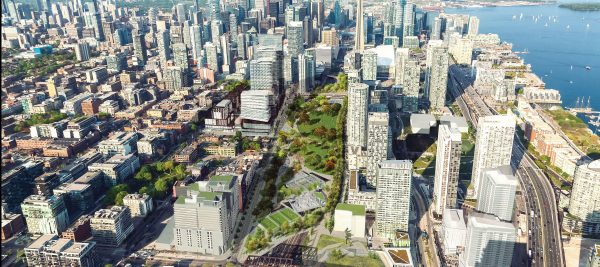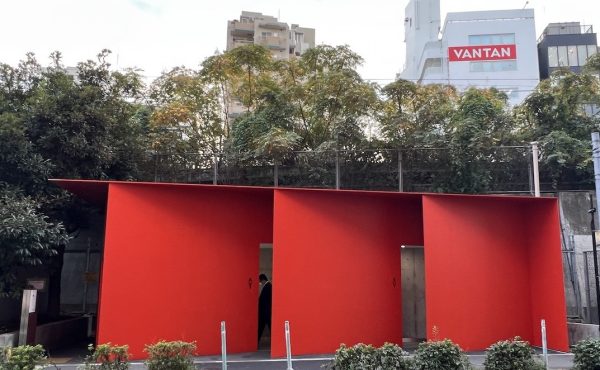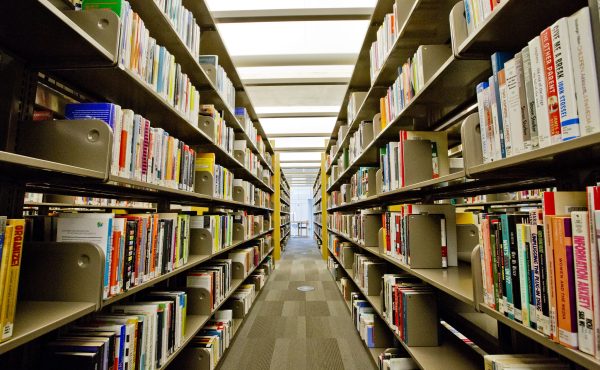If Toronto’s Rail Deck Park plan ended up dying in a dense thicket of legalistic land-use planning arguments, it would be fair to say that the idea began with a fundamental and, in this case, tragic, misapprehension — which was that the void between Front Street and City Place was somehow there for the taking, a kind of airborne expanse of urban crown land, waiting to be assigned a higher civic duty.
We all fell for it.
The two points on this continuum, of course, are linked — the fantasy begetting the tunnel vision that allowed most of us to overlook one of the critical lessons of Toronto in the 1980s, which was that nothing involving the railway lands came free or easily, and rarely turned into that thing so many people dreamt of.
Some early railway lands plans (from the left) included mid-rise social housing and townhouses. Others (from the right and Bay Street) had more office buildings and fewer apartment towers. There was all sorts of fighting and horse-trading about the stadium, both in council and then at the Ontario Municipal Board. We all know how the story ended.
Except we didn’t. “The proposed park,” a 2017 City rail deck corridor planning study noted, “will transform the unused air space above the rail corridor into Toronto’s next great gathering space for recreation, culture, and celebration [emphasis added].” In hindsight, this statement reminds me of the old joke about the economist who spots a $100 bill on the sidewalk but walks past it. “After all,” she thinks, “if that had really been a $100 bill, someone else would have picked it up already!”
Besides providing fodder for Mark Osbaldeston’s next instalment of Unbuilt Toronto, this episode should prompt some serious reflection about what we actually desire in parks in this city, because it seems all too easy to lapse into a form of wishful thinking that fails to account for both the way urban land develops and what we value in public space.
Many of the signature parks in global cities either began as the re-purposed estates of wealthy people or were carved out of barely urbanized areas on the periphery – think New York’s Central Park, which predates the development of mid-town Manhattan. High Park, Allan Gardens and Trinity Bellwoods were all parks well before they were surrounded by city.
Chicago has a picturesque waterfront because the 19th century merchant princes who had lake-front estates bullied the city into protecting their Michigan Avenue views in perpetuity. A century later, Chicago managed to put a lid on its decommissioned railyards, but Millennium Park ended up being financed by a confection of underground parking revenue and above-ground corporate graft, all of it shifted into position by an authoritarian mayor.
If I had to guess how Rail Deck Park would have turned out, I’d probably look to Boston, and the reclaimed land over the expressways buried during the $25 billion Big Dig. The project was touted as a way of reconnecting Boston with its harbour, but the resulting public spaces have a meh quality. Maybe one day they’ll have life, but not yet.
In the case of Toronto, our best loved public spaces have little to offer by way of learning. Metro in the 1950s created the Toronto Islands parks by quashing most the commercial activity. The Don Valley ravine system once included farms, cottages and some industrial activity, and only later did Metro restrict those areas for parks and expressways. In neither case were large commercial interests pushing against these re-uses.
In the early 2000s, the federal Liberals gifted the city with the decommissioned bits of the Downsview lands, touting it as Canada’s largest urban park. Expensive designers swept in with ridiculous landscaping concepts. But absent any kind of consistent revenue stream and a coherant planning strategy for city-building around the edges, Downsview Park remains a wind-swept disappointment and a reality check about over-hyped visions.
I hope the same fate won’t befall the park and naturalized spaces being carved out of the Port Lands to create the Lower Don flood protection zone. Certainly, there’s been no shortage of visual teasers, but that plan, unlike Downsview, came equipped with sufficient capital ($1.25 billion) to see it properly executed. (The same was true for Corktown Common.)
The parks planned for the Lower Don also sit on contested former industrial lands, and were once the target of Doug Ford’s scheming. But whereas the parkification of the Don flood plane enables development that would not have otherwise have occurred, Rail Deck Park’s raison d’etre – open space, connectivity – wasn’t a pre-condition to anything that private developers aren’t already doing. Two decking projects are underway, and the ORCA/Moshe Safdie plan that prevailed at the LPAT last week makes three. There will be more in the future.
I’d argue the defeat of the Rail Deck vision presents an opportunity for the City to not only re-consider how it thinks about parks and open space, but also cure us of our desire to somehow reverse engineer Central Park.
What does that re-booting of priorities look like? The answers are not a mystery: expansion of the sorts of open spaces that have proven to be hugely successful – e.g., the West Toronto Railpath or the Bentway; more investment in protecting the ravine system slopes, surfacing the buried rivers, and enabling better accessibility; and a re-imaging of existing downtown parks or other open-spaces that have been left to languish.
One more: the City should abandon the phony privately-owned public spaces (POPS) strategy and focus instead on creating more compact plazas and squares in medium and high-density areas slated for re-development. Some of this planning is now taking place — notably, part of a complicated deal announced last week involving a city-owned parking lot and an old fire hall between Adelaide and Richmond. Indeed, these kinds of parks, to my eye, are inherently more urban than green-space megaprojects, with their verdant renderings.
The Rail Deck story is not just a cautionary tale, but should also serve as a prompt about what the city can do well, in terms of open space. Better to build on those successes than attempt more moonshots.






9 comments
Thank you putting this into perspective with our history of failed open-spaces. Linking Downsview Park to Rail Deck Park brings the city failures home. As we can tell from history, parks have never been a real priority for our politicians. Most of the best modern public spaces in Toronto have been delivered by Waterfront Toronto and not the City of Toronto which our leaders should be ashamed about.
Look upstream from the Portlands and ask what has happened since Mayor Tory and Geoff Cape of Evergreen announced the Don River Valley Park. Vastly cheaper and larger than Rail Deck park, an expanded and improved DRVP would create a expand access to the Portlands through numerous neighbourhoods of Toronto.
What needs to get done?
First, get the Old CP Don Branch out of Metrolinx’s hands.
Second, begin planning for Toronto;s first museum dedicated to history *before* 1787 – near where the Don (Wonscotonach) meets the east/west Davenport trail would be perfect.
Third, focus the ravine funding towards crushing Dog Strangling Vine and establishing oak, pine and sugar maple in the lower Don Valley as the predominate forest.
Fourth – the Half Mile Bridge, that’s where the big plan should be.
check out the WonscotonachTrail.ca
Agree totally. Extensive travel abroad has allowed me to realize that mega parks are indeed wonderful destinations for locals and tourists alike, but it is the many small treed plazas and squares built as integral parts of the residential core that make it all worth living. Small gardens, pet enclosures, seating, a playground and a fountain all do the soul good. Lets rethink it!
Steve Poulin
Toronto
Chris — there will be a Museum of Toronto at Old City Hall. No one is gonna go to a museum out there. They’ll go for expensive lattes and a tour of the distillery, but your idea of putting a museum out there is odd, at best.
Just curious….why can’t raildeck park be built over the rail lands EAST of union station. Why always the focus on the west side?
Rail Deck Park was a great vision, Toronto could not advance financially right away and was accordingly slow to fully legally commit to (even before LPAT decision).
The problem with ORCA proposal is that building it along the south side of Front Street puts MUCH MORE adjacent density and likely park use (and intrusive bulk from its parking level outcrops) onto a MUCH SMALLER park, already much needed in the area. I think the vision can be continued, but now the LPAT decision would likely make expropriation cost prohibitive.
So. as Lorinc says, and I and other commentators approve, we need to innovate with more smaller intimate park spaces.
Dale
Good point Glenn! There is space to the east and west of the ORCA project. If John Tory is serious about a Rail Deck type Park, he has options. Not only that, if you add ORCA + a rail deck park, Toronto will end up with much more park space than originally envisioned.
Also, it’s not downtown but we can deck over the Allen Expressway.
Thanks for this; but we’ve kinda missed it all up, again, and very specifically avoiding a transit-first way of thinking about things ie. (restoring) transit on Front St. Not local, but robust, semi-express and in RoW from the pinch point at base of High Park in to the core, like a Front St. Extension, but a transitway. That faster-transit need has been somewhat obvious for decades, (1992 WWLRt EA urged its study) and while GO is good, upgrading for a robust quick line is likely a winner. Key to doing it well was having a transit mentality in the very core, and not just for the remnant strip of the Lands and Garden Trust on the south side of Front between Spadina and Bathurst that was or is maybe an extra lane for transit usage. But it was first to be ‘developed’ under City’s ‘plan’.
Maybe we can still adapt proposal that ‘won’ for a public RoW for transit, as what are the odds we’ll get a redo of the Gardiner for busways and bikeways and price of paint for instance? Maybe an LRT instead?
With mention of Lands and Gardens Trust above, apparently when TO was very small, c 1860s all the land south of Front St. was supposed to be ‘reserved for a public pleasure ground’ – and clearly, didn’t happen, and railways instead did, some on the forceful side with one fatality. So there’s massive gain in tax revenue and property value over the decades, and there thus should be a massive budget contribution as a priority to make things better, with the main need being better transit aligned with the Front St./massive E/W demand for mobility (and yes, squeeze the cars after making transit better). By trimming car use, that can enable parking spots on public space everywhere to be more park-ish.
We should also be mindful that it’s the cars that maybe should be buried, not the transit.
Another spot for decking over would be in Parkdale, and spacing did a good post a time ago about a campaign idea of John Sewell for just that in the 1980s.
A transit-first approach should also be taken with linear routes/resources in the Don Valley ie. some surface Relief by re-using less-efficiently used linears like the Bayview, the spur line with the Half-Mile bridge, and yes, maybe parts of the DVP as well.
Thanks for this. I think this is for the best. When I look at all projects like the Rail Desk I’m reminded of a pal’s Condo is now looking at a huge bill rebuilding a 1970’s underground parking structure. Given the countless projects to repair the Gardener, what a thing like this will cost to repair.
As for ORCA; why do designers continue to illustrate tall buildings with plants lolling all over them? One just has to walk on Front at the Convention centre or CBC building & note the “Danger Falling Ice & Snow” signs to note how these poorly designed things are a hazard. Can’t wait to read about all the cool kids complaints about Trash Pandas on 20 storey sky bridge “Urban Farms”. I’m sure all the plants in the deep north shade will remain perfect, just like the planter boxes in front of the convention centre. I know most Torontoians try to ignore winter, but it is a thing.